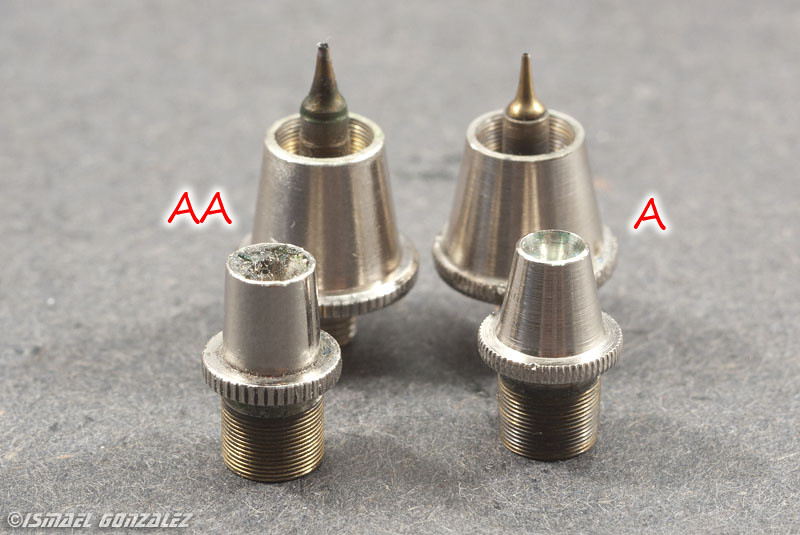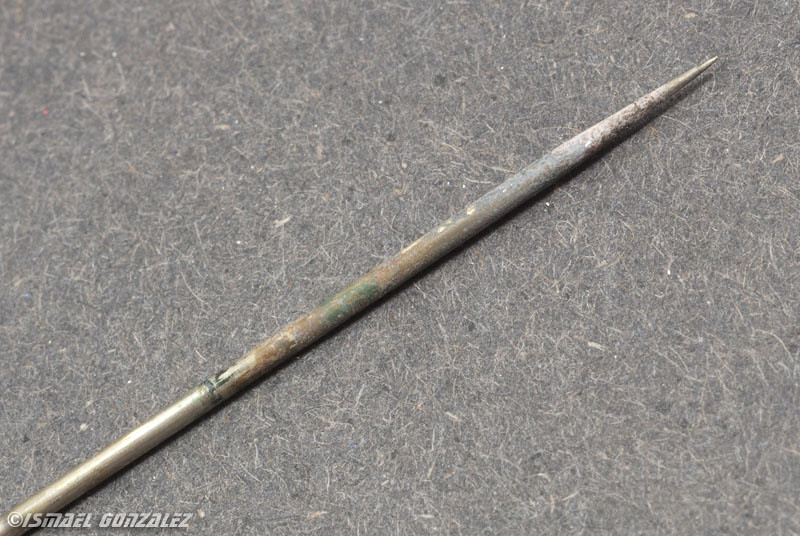tatocorvette
Mac-Valve Maestro!
Hello,
Disclaimer: DaveG, 2Diverse and other more knowledgeable folks, please keep me honest here if there is any correction.
Background:
Thayer & Chandler started to manufacture airbrushes in 1891, using Burdick's patented internal mix design. They quickly started to work on refining and improving on the concept. Multiple patents followed including many submitted by Olaus Wold as a Thayer & Chandler employee. He later left and founded his own company: The Wold airbrush Company.
At the dawn of the 20th century, Thayer & Chandler introduced the side feed concept, allowing the airbrush to be tilted in any angle. This was the starting point for the eventual Model A. Thayer & Chandler's Model A airbrush was produced for basically most of the 20th century, until it finally closed in the very late 90's.
With subtle and not so subtle changes and evolutions thru time, the Model A became the most popular airbrush from the company and one of the most popular airbrushes in the world despite competition from Wold, Aerograph (later DeVilbiss), Paasche and others. Also, the Model A is arguably the starting point for Badger airbrushes.
So, the Model A was very popular. However, there is a variation that seems to be rather obscure: The Model AA. There is very little information out there about the Model AA.
From what I have gathered, the very few Model AAs I've seen (a handful online and 2 in my hands) share the post mid-sixties last body iteration which has a stylized tapered front. If that holds true, then it was a later model from no earlier than the mid to late 60s. The AA and the A share the same body, but the model designation is engraved. So what's the difference?
As part of my research, I found online a Thayer & Chandler catalog from 1977:

The AA retailed for $61. That was $2 more than the Model A.
In the parts list, there are separate needle, regulator, tip and head for each model. Everything else (body, trigger, air valve, needle springs/chuck etc.) is shared between the models.
As you will see next, I find the AA parts suspiciously similar to the Badger parts of the day. I suspect the 2 companies had a very close relationship, probably more than simply one supplying parts for the other. Badger eventually acquired Thayer & Chandler about 2 years after closing. There were some legal issues over patents, intellectual property and trade secrets according to Badger.
My specimen:
I got a lot of 4 "as-is/non-working" Thayer & Chandler airbrushes.

To my surprise, 2 of them were AAs! But, the lot was a mess of mixed and jumbled parts. I noticed A and AA parts mixed and mis-matched. It seems they were disassembled and then thrown together carelessly in a hurry.
From the mess, I was able to make one fully functional AA. It seems the two As can be salvaged as well but I haven't gone there yet.
Here are the differences between the 2 models:
Head and nozzle tip are bigger. I think the Model A can be considered a "Fine" setup and the AA would be a medium or heavy. Also, both AA heads had the white teflon washer typically associated with Badger. Not sure if they are "original".
Yes, these parts were in nasty condition.


The needles are harder to tell apart. I compared what I think is the AA needle with my still new spare A needle. It seems the AA is a hair shorter and less pointy. But these needles were in rough shape before I cleaned them.


I noticed the tip was a bit rough. Keep in mind this is hard to see with the naked eye.

Very carefully and gently, using a jeweler's file and the lightest touch. I stopped before damaging it.

The other AA body is in rougher shape. Worth noting, this other body is older based on the much lower serial number and the trigger is the older style which makes the trigger seat on top of the air valve also different. So the triggers should not be interchanged.
This is still considered an "On-going" project.

At the end, I was able to sort and gather parts for a complete AA. Everything was deeply cleaned and polished. As a side note, the cup was pretty nasty and had to take a swim in lacquer thinner followed by an angry Dremel with a wire wheel.


Presenting my "new" Thayer & Chandler Model AA






It has a more modern "business look" compared to more vintage units.
Pretty, but, does it work?
I put together this quick and dirty video. This was done after midnight so don't expect a Hollywood production
**EDIT** As a grammar police I'm issuing a ticket to myself! The video should say "breathing". That's what happens when you do things well after bedtime
I hope you like it. Appreciate your comments and questions.
Thanks,
Ismael
Disclaimer: DaveG, 2Diverse and other more knowledgeable folks, please keep me honest here if there is any correction.
Background:
Thayer & Chandler started to manufacture airbrushes in 1891, using Burdick's patented internal mix design. They quickly started to work on refining and improving on the concept. Multiple patents followed including many submitted by Olaus Wold as a Thayer & Chandler employee. He later left and founded his own company: The Wold airbrush Company.
At the dawn of the 20th century, Thayer & Chandler introduced the side feed concept, allowing the airbrush to be tilted in any angle. This was the starting point for the eventual Model A. Thayer & Chandler's Model A airbrush was produced for basically most of the 20th century, until it finally closed in the very late 90's.
With subtle and not so subtle changes and evolutions thru time, the Model A became the most popular airbrush from the company and one of the most popular airbrushes in the world despite competition from Wold, Aerograph (later DeVilbiss), Paasche and others. Also, the Model A is arguably the starting point for Badger airbrushes.
So, the Model A was very popular. However, there is a variation that seems to be rather obscure: The Model AA. There is very little information out there about the Model AA.
From what I have gathered, the very few Model AAs I've seen (a handful online and 2 in my hands) share the post mid-sixties last body iteration which has a stylized tapered front. If that holds true, then it was a later model from no earlier than the mid to late 60s. The AA and the A share the same body, but the model designation is engraved. So what's the difference?
As part of my research, I found online a Thayer & Chandler catalog from 1977:

The AA retailed for $61. That was $2 more than the Model A.
In the parts list, there are separate needle, regulator, tip and head for each model. Everything else (body, trigger, air valve, needle springs/chuck etc.) is shared between the models.
As you will see next, I find the AA parts suspiciously similar to the Badger parts of the day. I suspect the 2 companies had a very close relationship, probably more than simply one supplying parts for the other. Badger eventually acquired Thayer & Chandler about 2 years after closing. There were some legal issues over patents, intellectual property and trade secrets according to Badger.
My specimen:
I got a lot of 4 "as-is/non-working" Thayer & Chandler airbrushes.

To my surprise, 2 of them were AAs! But, the lot was a mess of mixed and jumbled parts. I noticed A and AA parts mixed and mis-matched. It seems they were disassembled and then thrown together carelessly in a hurry.
From the mess, I was able to make one fully functional AA. It seems the two As can be salvaged as well but I haven't gone there yet.
Here are the differences between the 2 models:
Head and nozzle tip are bigger. I think the Model A can be considered a "Fine" setup and the AA would be a medium or heavy. Also, both AA heads had the white teflon washer typically associated with Badger. Not sure if they are "original".
Yes, these parts were in nasty condition.


The needles are harder to tell apart. I compared what I think is the AA needle with my still new spare A needle. It seems the AA is a hair shorter and less pointy. But these needles were in rough shape before I cleaned them.


I noticed the tip was a bit rough. Keep in mind this is hard to see with the naked eye.

Very carefully and gently, using a jeweler's file and the lightest touch. I stopped before damaging it.

The other AA body is in rougher shape. Worth noting, this other body is older based on the much lower serial number and the trigger is the older style which makes the trigger seat on top of the air valve also different. So the triggers should not be interchanged.
This is still considered an "On-going" project.

At the end, I was able to sort and gather parts for a complete AA. Everything was deeply cleaned and polished. As a side note, the cup was pretty nasty and had to take a swim in lacquer thinner followed by an angry Dremel with a wire wheel.


Presenting my "new" Thayer & Chandler Model AA






It has a more modern "business look" compared to more vintage units.
Pretty, but, does it work?
I put together this quick and dirty video. This was done after midnight so don't expect a Hollywood production
**EDIT** As a grammar police I'm issuing a ticket to myself! The video should say "breathing". That's what happens when you do things well after bedtime
I hope you like it. Appreciate your comments and questions.
Thanks,
Ismael
Last edited:
